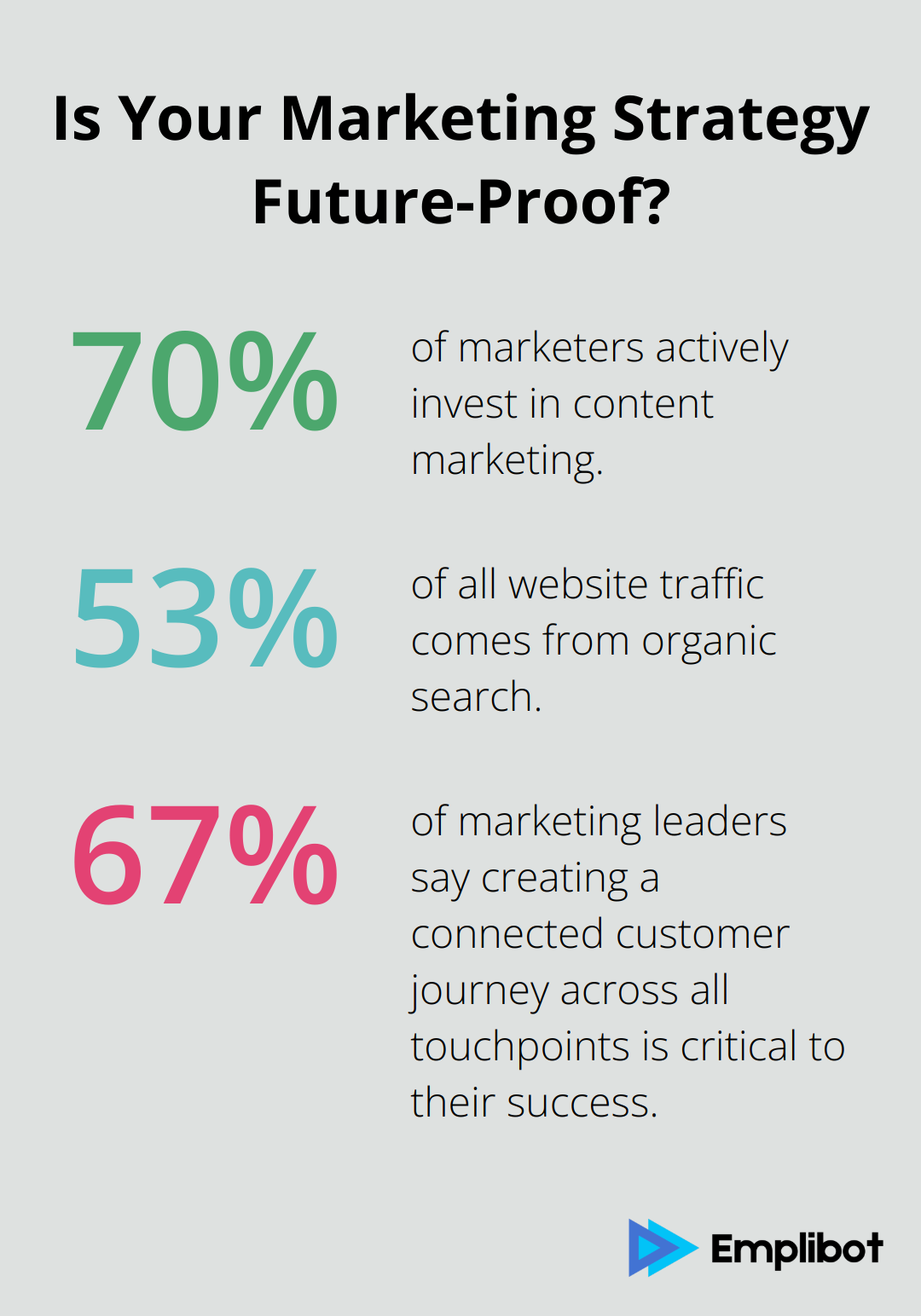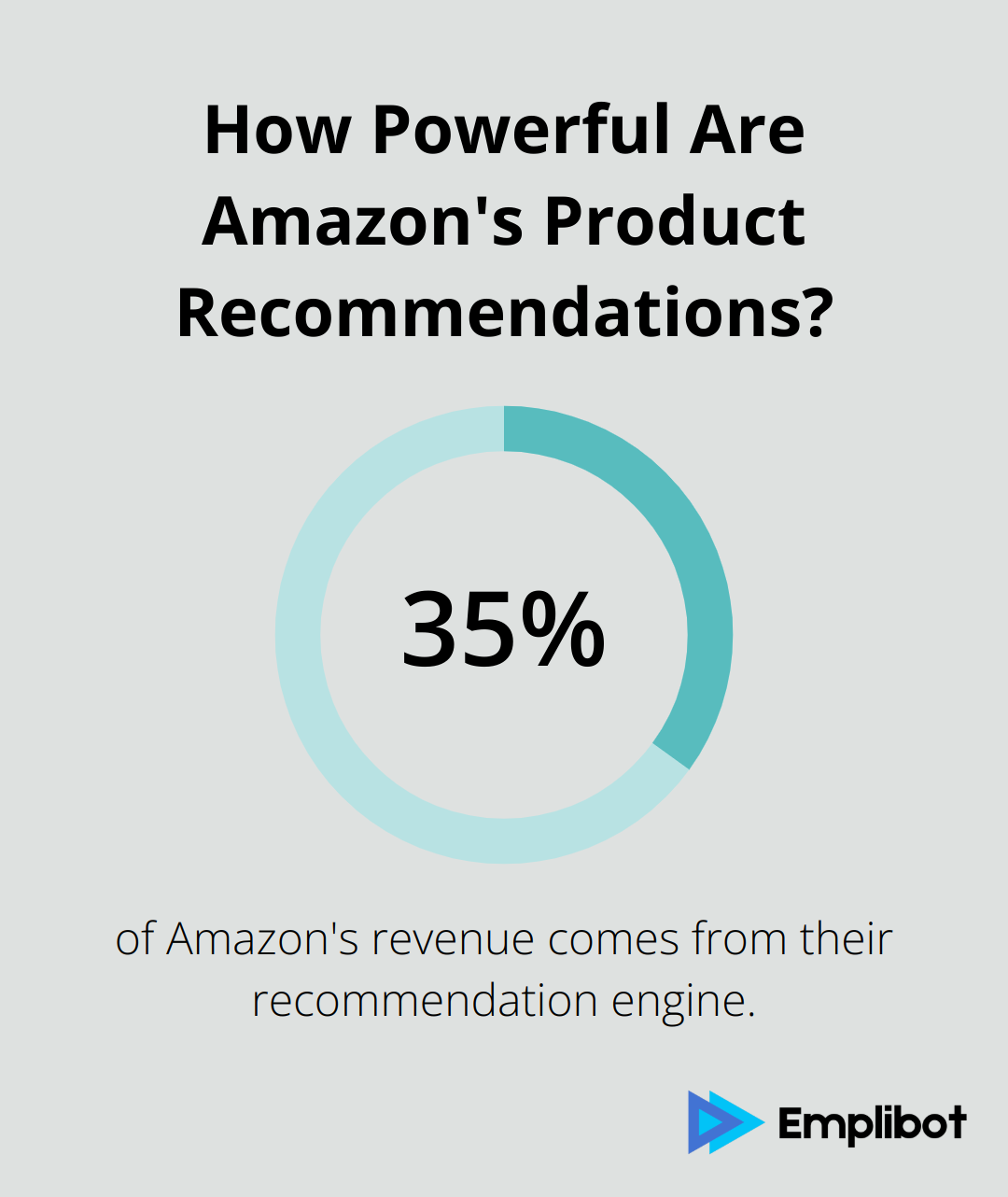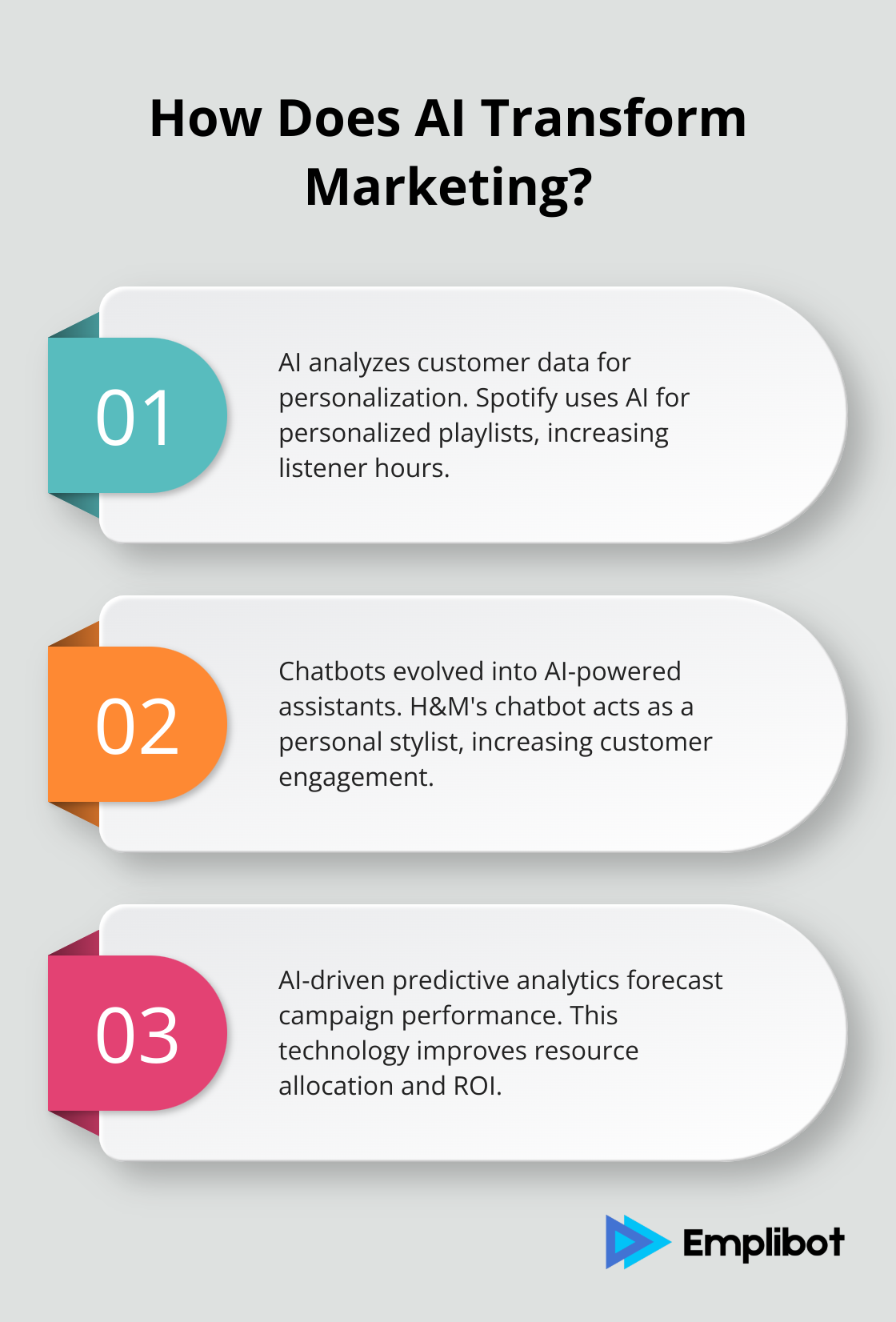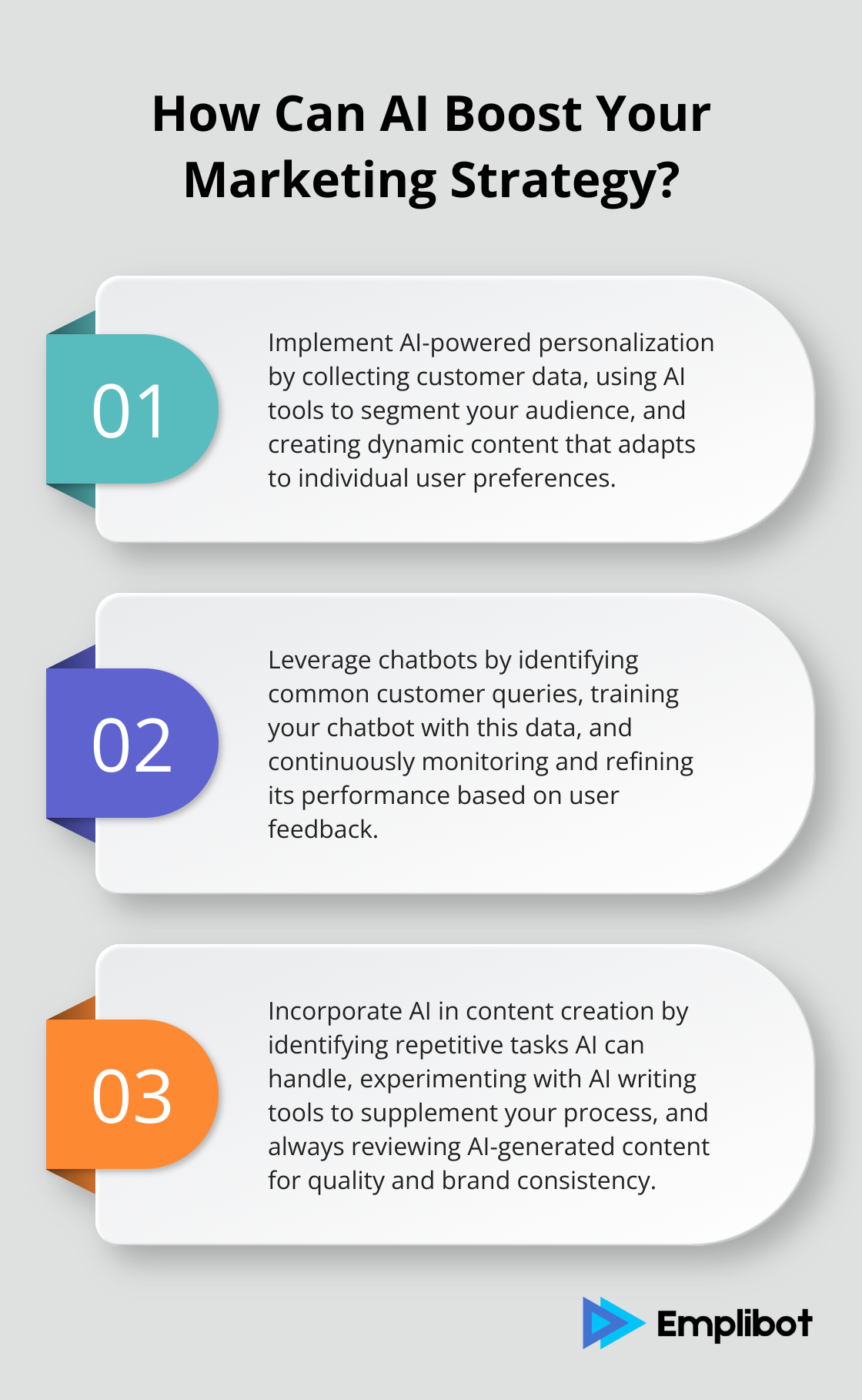Digital transformation is reshaping the marketing landscape at breakneck speed. At Emplibot, we’ve witnessed firsthand how this shift is revolutionizing the way businesses connect with their audiences.
From data-driven strategies to emerging technologies, digital transformation in marketing is opening up new possibilities for engagement and growth. In this post, we’ll explore the key elements driving this change and how companies can harness them for success.
How Digital Marketing Transforms Business
The Digital Marketing Revolution
The landscape of marketing has undergone a seismic shift in recent years. Traditional marketing methods like print ads, billboards, and TV commercials no longer serve as the primary focus for businesses aiming to reach their target audience. Instead, digital marketing has taken center stage, offering unprecedented opportunities for engagement, measurement, and personalization.

Digital marketing has revolutionized how businesses connect with consumers. A report by eMarketer shows that digital ad spending worldwide reached $378.16 billion in 2020 (a 12.7% increase from the previous year). This growth underscores the increasing importance of digital channels in marketing strategies.
One of the key advantages of digital marketing is its ability to reach a global audience. With over 4.66 billion active internet users worldwide as of January 2021 (Statista), businesses can now tap into markets that were previously inaccessible through traditional means.
Dominant Digital Marketing Channels
Several digital marketing channels have emerged as powerhouses for businesses:
- Social Media Marketing: Platforms like Facebook, Instagram, and LinkedIn have become essential for brand building and customer engagement. With 3.6 billion people using social media globally (Statista), these platforms offer unparalleled reach.
- Content Marketing: High-quality, relevant content helps businesses attract and retain customers. HubSpot reports that 70% of marketers actively invest in content marketing.
- Search Engine Optimization (SEO): Optimizing website content for search engines is vital for visibility. BrightEdge states that 53% of all website traffic comes from organic search.
- Email Marketing: Despite being one of the older digital marketing channels, email remains highly effective. Campaign Monitor reports that email marketing generates $42 for every $1 spent.
- Pay-Per-Click Advertising (PPC): Platforms like Google Ads allow businesses to target specific audiences with precision. Google’s economic impact report shows that businesses make an average of $2 in revenue for every $1 they spend on Google Ads.
Shifting Consumer Behavior
The rise of digital marketing has profoundly impacted consumer behavior and expectations. Today’s consumers expect personalized experiences, immediate responses, and seamless interactions across multiple devices and platforms.
Salesforce surveyed senior marketing industry leaders and discovered that 67% of marketing leaders say creating a connected customer journey across all touchpoints is critical to their success. This demand for personalization has led to the increased use of data analytics and AI in marketing strategies.
Moreover, the convenience of online shopping has transformed consumer purchasing habits. In 2020, global e-commerce sales reached $4.28 trillion and are projected to grow to $5.4 trillion in 2022 (Statista).
The Future of Digital Marketing
As digital technologies continue to evolve, so too will the landscape of digital marketing. Businesses must stay ahead of the curve by embracing new tools and strategies. The integration of artificial intelligence, virtual reality, and voice search optimization will likely play significant roles in shaping the future of digital marketing.
The next frontier of digital marketing lies in harnessing data to drive more targeted and effective marketing strategies. As we move into this data-driven era, businesses must learn to leverage the wealth of information at their disposal to create more personalized and impactful marketing campaigns.
How Data Drives Your Marketing Success
The Power of Big Data in Marketing
In the digital age, data powers effective marketing strategies. McKinsey’s study reveals that companies extensively using customer analytics are 23 times more likely to outperform competitors in new customer acquisition. This statistic highlights the immense potential of data-driven marketing strategies.

Big data provides a comprehensive view of the customer. Data collection and analysis from various touchpoints (website visits, social media interactions, purchase history) offer deep insights into customer behavior, preferences, and needs.
Netflix exemplifies this approach. The streaming giant analyzes viewing habits and preferences of its 231 million subscribers worldwide. Their data-driven strategy results in 80% of viewer activity influenced by their recommendation system.
Personalization: The Key to Customer Engagement
Personalization has transformed from a luxury to a necessity in marketing. Epsilon’s study found that 80% of consumers are more likely to make a purchase when brands offer personalized experiences.
Amazon stands out in successful personalization. Their recommendation engine, powered by machine learning algorithms, accounts for 35% of the company’s revenue. Amazon creates highly personalized product recommendations for each user through analysis of past purchases, browsing history, and time spent on specific products.
To implement effective personalization strategies:
- Collect relevant customer data points
- Create detailed customer segments
- Tailor marketing messages accordingly
Predictive Analytics: Forecasting Future Trends
Predictive analytics elevates data-driven marketing by using historical data to forecast future trends and behaviors. This tool allows marketers to anticipate customer needs, optimize marketing spend, and improve overall campaign performance.
Forrester Research found that B2B marketers who implement predictive analytics are 2.9 times more likely to report revenue growth at rates higher than the industry average.
Practical applications of predictive analytics include:
- Lead scoring: Identify characteristics and behaviors of your most valuable customers to focus marketing efforts on high-potential prospects.
- Churn prediction: Analyze customer behavior patterns to identify signs of potential customer loss, enabling proactive retention measures.
To start with predictive analytics, invest in tools that integrate with your existing marketing technology stack. Many marketing automation platforms (Emplibot being a top choice) offer predictive analytics features that help make data-driven decisions without requiring advanced technical skills.
While data is powerful, it’s not a magic solution. Success lies in asking the right questions, interpreting data correctly, and taking actionable steps based on insights. Start small, test different approaches, and continuously refine your strategies based on results.
As we move forward, it’s essential to consider how emerging technologies are shaping the future of digital marketing. The next section will explore cutting-edge tools and techniques that are revolutionizing the way businesses connect with their audiences.
How AI Transforms Your Marketing
AI-Powered Personalization
Artificial intelligence (AI) and machine learning (ML) revolutionize the marketing landscape. These technologies enhance marketing efforts significantly.
AI and ML algorithms analyze vast amounts of customer data to deliver hyper-personalized experiences. Spotify uses AI to create personalized playlists for its users, resulting in an increase in listener hours.

To implement AI-powered personalization:
- Collect and organize your customer data.
- Use AI tools to segment your audience based on behavior patterns.
- Create dynamic content that adapts to individual user preferences.
Chatbots and Conversational AI
Chatbots evolved from simple rule-based systems to sophisticated AI-powered assistants. They handle customer inquiries, provide product recommendations, and even process transactions.
H&M’s chatbot acts as a personal stylist, offering outfit recommendations based on user preferences. This approach led to an increase in customer engagement.
To leverage chatbots effectively:
- Identify the most common customer queries and interactions.
- Train your chatbot using this data to provide accurate and helpful responses.
- Monitor and refine your chatbot’s performance based on user feedback continuously.
Predictive Analytics for Campaign Optimization
AI-driven predictive analytics forecast campaign performance and suggest optimizations. This technology allows marketers to allocate resources more efficiently and improve ROI.
To start with predictive analytics:
- Choose a predictive analytics tool that integrates with your existing marketing stack.
- Start with a specific use case (such as predicting customer churn or identifying high-value prospects).
- Use the insights gained to refine your marketing strategies and tactics.
AI-Powered Content Creation
AI tools now assist in content creation, from generating ideas to writing full articles. These tools analyze vast amounts of data to produce relevant and engaging content tailored to specific audiences.
For example, AI-powered summarization enhances efficiency and allows media organizations to tailor content to specific audiences.
To incorporate AI in your content creation:
- Identify repetitive content tasks that AI can handle.
- Experiment with AI writing tools to supplement your content creation process.
- Always review and edit AI-generated content to ensure quality and brand voice consistency.
AI in Email Marketing
AI transforms email marketing by optimizing send times, personalizing content, and predicting customer behavior. This leads to higher open rates, click-through rates, and conversions.
Phrasee, an AI-powered copywriting tool, helped Virgin Holidays increase their email open rates and click-through rates. The tool generates and optimizes email subject lines, body copy, and calls-to-action.
To leverage AI in your email marketing:
- Use AI tools to segment your email list based on behavior and preferences.
- Implement AI-powered subject line optimization.
- Test AI-generated email content against human-written content to measure performance.
Final Thoughts
Digital transformation has reshaped the marketing landscape, introducing data-driven strategies and cutting-edge technologies. Marketers now possess unprecedented tools to connect with audiences and drive results. The future of digital transformation in marketing promises even more exciting developments, including advancements in AI, virtual reality, and voice search.

Marketers must adapt to these changes and innovate to thrive in this dynamic digital landscape. Those who embrace new technologies and strategies will position themselves for success. Emplibot understands the challenges and opportunities presented by digital transformation in marketing.
Our automated content marketing solution helps businesses navigate this complex landscape. Emplibot handles everything from keyword research to content creation and distribution, enabling companies to stay at the forefront of digital marketing trends while saving time and resources. The digital transformation of marketing represents a fundamental shift in how businesses connect with their audiences.

